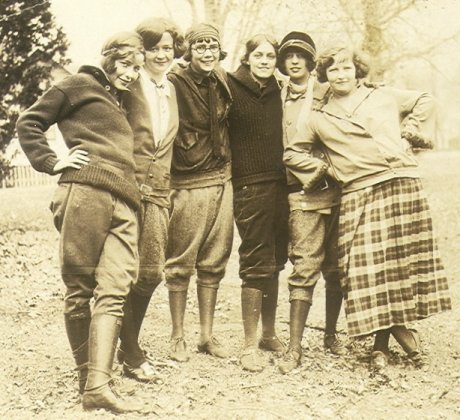Just
before the 20's,in the year 1918, there was the end of WW1. Everyone seemed to have an attitude change.
People began to look forward. Designers picked up on new youthfullness
and contempory modernism that society was searching for.
Undergarments began to transform after World War I to conform to the ideals of a flatter chest and more boyish figure. The womens rights movement had a strong effect on women's fashions. Most importantly, the confining corset was discarded, replaced by a chemise or camisole and bloomers, later shortened to panties or knickers. During the mid-twenties all-in-one lingerie became popular.
A more masculine look became popular, including flattened breasts and hips, short hairstyles such as the bob cut. The fashion was bohemian and forthcoming for its age.

Teenage girls in Minnesota wear breeches and riding boots with men's neckties, 1924.

Knee length pleated skirts and dropped waists were still popular as everyday clothes in 1929.

Menswear
In the early twenties, men's fashion was characterized by extremely high waisted jackets, often worn with belts. Trousers were relatively narrow and straight (never tapered) and they were worn rather short so that a man's socks often showed. Trousers also began to be worn cuffed at the bottom at this time.
By 1925, wider trousers commonly known as "Oxford Bags" came into fashion, while suit jackets returned to a normal waist and lapels became wider and were often worn peaked.
Peoples
behaviour also seemed to characterize the 1920's. Manners were less
formal, clothes were more casual and younger people were free to live
away from there parents.
Then, the
girls rebelled, They smoked in public places, cut off their hair, wore
make up, skirts went shorter and they went to parties un chaperoned.
Flapper girls
Man in 1927 wearing a Panama Hat and buttoned waistcoat.
Flapper
in the 1920s was a term applied to a “new breed” of young western women
who wore short skirts, bobbed their hair, listened to jazz, and
flaunted their disdain for what was then considered acceptable behavior.
Flappers were seen as brash for wearing excessive makeup, drinking,
treating sex in a casual manner, smoking, driving automobiles and
otherwise flouting social and sexual norms.
Young men
wore casual clothes too, they drank cocktails, the wealthier ones drove
the best cars, sports clothing was a fashion statement.
Young women
strived to be like the hollywood movie stars.. again, pretty similar to
2012. Then came the eye make up trend. The 'vamped' look, making the
eyes the focal point of the face. They were dark and intensely dramatic.
Womens dresses were flowing and bias cut. The bias cut was originally introduced by Madeleine Vionnet.
The boyish figure for women?
Undergarments began to transform after World War I to conform to the ideals of a flatter chest and more boyish figure. The womens rights movement had a strong effect on women's fashions. Most importantly, the confining corset was discarded, replaced by a chemise or camisole and bloomers, later shortened to panties or knickers. During the mid-twenties all-in-one lingerie became popular.
A more masculine look became popular, including flattened breasts and hips, short hairstyles such as the bob cut. The fashion was bohemian and forthcoming for its age.

Teenage girls in Minnesota wear breeches and riding boots with men's neckties, 1924.

Knee length pleated skirts and dropped waists were still popular as everyday clothes in 1929.

Menswear
In the early twenties, men's fashion was characterized by extremely high waisted jackets, often worn with belts. Trousers were relatively narrow and straight (never tapered) and they were worn rather short so that a man's socks often showed. Trousers also began to be worn cuffed at the bottom at this time.
By 1925, wider trousers commonly known as "Oxford Bags" came into fashion, while suit jackets returned to a normal waist and lapels became wider and were often worn peaked.
The boyish figure for women?
Undergarments began to transform after World War I to conform to the ideals of a flatter chest and more boyish figure. The womens rights movement had a strong effect on women's fashions. Most importantly, the confining corset was discarded, replaced by a chemise or camisole and bloomers, later shortened to panties or knickers. During the mid-twenties all-in-one lingerie became popular.
A more masculine look became popular, including flattened breasts and hips, short hairstyles such as the bob cut. The fashion was bohemian and forthcoming for its age.

Teenage girls in Minnesota wear breeches and riding boots with men's neckties, 1924.

Knee length pleated skirts and dropped waists were still popular as everyday clothes in 1929.

Menswear
In the early twenties, men's fashion was characterized by extremely high waisted jackets, often worn with belts. Trousers were relatively narrow and straight (never tapered) and they were worn rather short so that a man's socks often showed. Trousers also began to be worn cuffed at the bottom at this time.
By 1925, wider trousers commonly known as "Oxford Bags" came into fashion, while suit jackets returned to a normal waist and lapels became wider and were often worn peaked.
Man in 1927 wearing a Panama Hat and buttoned waistcoat.





